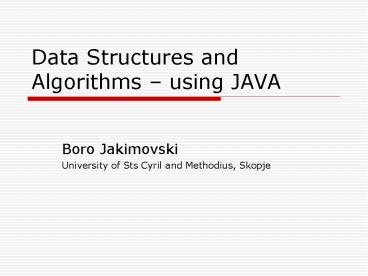Data Structures and Algorithms - PowerPoint PPT Presentation
Title: Data Structures and Algorithms
1
Data Structures and Algorithms using JAVA
- Boro Jakimovski
- University of Sts Cyril and Methodius, Skopje
2
Data Structure course
- The course is organized in the following manner
- 2 hours lectures
- 1 hour tutorial
- 2 hours lab exercises
3
Data Structures course
- The tutorials and lab exercises are closely
coordinated with the lectures - The material covered in each lecture is later
covered in the tutorials from implementation
point of view using Java - Lab exercises extend the tutorials where each
student implements the assigned exercises
4
Lab exercises purpose
- Lab exercises main focus is to teach the students
to learn - How to implement certain data structures
- How to use already implemented data structures
- Learn how to use Java powerful library of already
implemented data structures
5
Organization
- The course is organized using moodle as a
courseware tool - The course is organized in weeks and each week
the students can download both the lectures and
the tutorials - Also for each week there are materials for
laboratory exercises acompanied with assignments
6
Lab work and Assignments
- The lab work consists of
- examples of already implemented problems
- partial solutions of problems
- assignments for lab and home work
- Assignments
- each week the students are obliged to upload the
solution for the given problem - this is later evaluated and together with the
projects make up a part of the final grade
7
Lab exercises
Following are the lab topics and exercises that
are given for each topic
- Binary trees
- Heap
- Search trees
- Graphs
- Java examples and repetition
- Asymptotical complexity of Java programs
- Basic data structures (arrays and lists)
- Abstract data types
- Stack, Queue, Dequeue
- Lists (different kinds of lists)
- Hash tables
8
Lab exercises
- Lab 1 Java examples and repetition
- Usage of data structures
- Sum up 11/21/3
- Implement the class RationalNumber with its
methods and atributes
- Lab 2 Asymptotical complexity of Java programs
- Given short programs with loops and calling other
methods with given complexity - Calculate the complexity
9
Lab exercises
- Lab 3 Basic data structures
- Given the implementations of CustomArray and
LinkedList - Implement additional methods for this structures
- Usage of this DS
- Lab 4 Abstract data types
- Implementation of Abstract Data Type using Java
Interfaces - Implementation of the interface Cardfile
10
Lab exercises
- Lab 5 Stack, Queue, Dequeue
- Given are the interface and the implementation of
Stack, Queue and Dequeue - Usage of the Stack in implementation of recursive
algorithms - Adding methods to the Data structures
- Lab 6 Lists (different kinds of lists)
- Explanation of the different kinds of lists
- Implementation of Double Linked Lists with given
methods
11
Lab exercises
- Lab 7 Hash tables
- Given the interface, implementations and the
usage of the hash table - Implement the hashCode() method
- Lab 8 Binary trees
- Given the Binary Tree Implementation
- Implement inorder and preorder traversal
- Implementation of Tree ADT
12
Lab exercises
- Lab 9 Heap
- Given the Heap data structure
- Implement the HeapSort algorithm
- Lab 10 Search trees
- Given the implementation of BynarySearchTree
- Implement the method deleteElement
- Implement AVT tree
13
Lab exercises
- Lab 11 Graphs
- Given the implementation of Graph
- Implement the following methods
- public Iterator nodes ()
- public Iterator edges ()
- public Iterator neighbors (graph.Node node)
- public Iterator connectingEdges (graph.Node
node)
14
Conclusion
- The course was very well structured and the
exercieses were shown to be very successful - Usage of Moodle was a good choice as the students
were very pleased of its simplicity - The main focus on the exercises was not only to
learn how to implement the DS but also how to use
them































